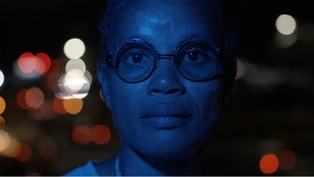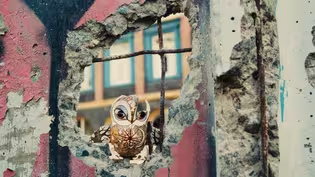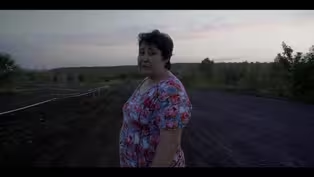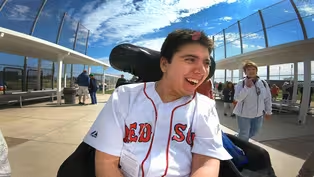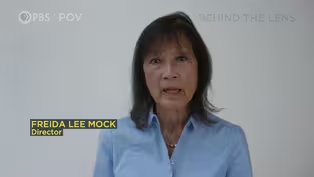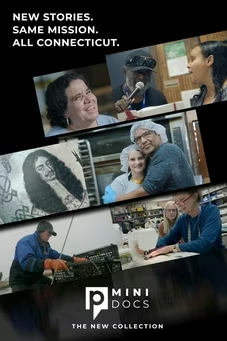
Maya Lin: A Strong Clear Vision
Season 38 Episode 5 | 1h 22m 54sVideo has Audio Description
Follow the journey of Maya Lin behind the controversial Vietnam Veterans Memorial in DC.
In a powerful exploration of art, politics and creativity, the Oscar winning film highlights the story behind the Vietnam Veterans Memorial in DC, one of the era’s most controversial monuments. At age 21, Lin, an artist and architecture student, shot to global fame when her design was selected. Facing an onslaught of public attacks, she remained steadfast in her vision.
See all videos with Audio DescriptionADProblems playing video? | Closed Captioning Feedback
Problems playing video? | Closed Captioning Feedback
Major funding for POV is provided by PBS, The John D. and Catherine T. MacArthur Foundation, the Wyncote Foundation, Reva & David Logan Foundation, the Open Society Foundations and the...

Maya Lin: A Strong Clear Vision
Season 38 Episode 5 | 1h 22m 54sVideo has Audio Description
In a powerful exploration of art, politics and creativity, the Oscar winning film highlights the story behind the Vietnam Veterans Memorial in DC, one of the era’s most controversial monuments. At age 21, Lin, an artist and architecture student, shot to global fame when her design was selected. Facing an onslaught of public attacks, she remained steadfast in her vision.
See all videos with Audio DescriptionADProblems playing video? | Closed Captioning Feedback
How to Watch POV
POV is available to stream on pbs.org and the free PBS App, available on iPhone, Apple TV, Android TV, Android smartphones, Amazon Fire TV, Amazon Fire Tablet, Roku, Samsung Smart TV, and Vizio.

POV Playlist
Every two weeks, we curate a selection of POV docs, old and new, around a central theme. Stream while you can — until the next Playlist!Providing Support for PBS.org
Learn Moreabout PBS online sponsorshipMore from This Collection
POV Broadcast Feature Films.
Video has Closed Captions
A Korean birth mother and her daughter struggle to stay reunited for the long haul. (1h 22m 58s)
Video has Closed Captions
Poet and activist Staceyann Chin chronicles her journey of healing, forgiveness, and mothering. (1h 23m 5s)
Video has Closed Captions
Confronting war, Ukrainian artists pick up arms while finding strength through art. (1h 22m 41s)
Video has Closed Captions
A small-town attorney takes on pharmaceutical giants as opioids devastate his community. (1h 22m 48s)
Video has Closed Captions
An environmental thriller that shines new light on the human cost of coal. (1h 22m 58s)
Video has Closed Captions
In rural Mexico, a community seeks answers, uncovering alarming truths about their water. (1h 14m 47s)
Video has Closed Captions
After losing it all, Desiree Wood takes a second lease on life as a long-haul trucker. (1h 23m 3s)
Video has Closed Captions
A family’s free life in nature is disrupted by tragedy, forcing them into modern society. (52m 53s)
Video has Closed Captions
A new “innovation district” tests local democracy in a divided Brooklyn community. (1h 22m 31s)
Video has Audio Description
A community of disability activists help Samuel Habib, 21, navigate the path to adulthood. (1h 22m 44s)
Video has Audio Description
Three women navigate hope and change as a Chinese industrial zone transforms Ethiopia. (1h 22m 54s)
Igualada: Refusing to Know Your Place
Video has Closed Captions
A Colombian Black rural activist's historic bid for presidency stirs a national awakening. (1h 19m 49s)
Providing Support for PBS.org
Learn Moreabout PBS online sponsorship♪♪ ♪♪ ♪♪ ♪♪ ♪♪ ♪♪ [ Indistinct conversations ] ♪♪ ♪♪ ♪♪ ♪♪ ♪♪ ♪♪ ♪♪ -Designing the piece, I knew that I had to ask myself what, you know -- what is a memorial's purpose?
Especially, what is a memorial's purpose in the 20th century?
♪♪ And all I was saying in this piece is the cost of war is these individuals, and we have to remember them first.
And so it's really the people, not the politics, which is what this piece is about.
♪♪ Because it's only when you accept the pain, it's only when you accept the death can you then come away from it, can you then overcome it.
And literally as you read a name or touch a name, and the pain will come out.
And I really did mean for people to cry.
That you can then have to, of your own power, turn around and walk back up into the light, into the present.
But if you can't accept death, you'll never get over it.
So what the memorial is about is about honesty, which is also what the civil rights piece is about.
You have to accept and admit that this pain has occurred in order for it to be healed, in order for it to be cathartic.
♪♪ ♪♪ ♪♪ -Did you see the others?
So many guys on the same day.
It's incredible.
-What difference does it make whether you find one name?
[ Crying ] Look at all the names.
-I know.
You know, some of them are special to you.
Some of them are special to you.
Others are special to other people.
♪♪ ♪♪ ♪♪ ♪♪ ♪♪ -There's nothing really like it.
There isn't anything really like it at all.
It doesn't make any specific gesture which can date it in time or in place.
It's all wars, all death, all living, and all dead at once.
It's a remarkable thing, and done by a girl of 20 or whatever.
It's really...
It's really unbelievable.
It's really hard to grasp.
-At Yale, I got together with maybe five other students, and we decided to set up our own course that would specifically deal with funereal architecture.
More importantly, how does man deal with death through the built form?
So the whole semester dealt with a number of studio projects.
One of us -- I can't remember who -- found a poster that advertised a competition for Vietnam Veterans Memorial.
And we said, "What a great idea.
Let's use that and make that our final project for this course."
-In 1979, I had seen a movie called "The Deer Hunter."
I decided after that movie, kind of in the middle of the night, that this memorial had to be built.
It was obvious that the United States government was not going to build it.
And I felt the memorial would only be built if I were to do it.
And this was my destiny.
-We set up the corporation and we found that it required an act of Congress in order to build the memorial on the Mall.
And on July 1st, 1980, President Carter signed the legislation.
The question, of course, then was what would the memorial look like and how would we -- how would we obtain a design?
-I just didn't really care what it looked like.
But when I thought of what it would look like, I really thought of something like an obelisk, a large obelisk with the names on the side and so forth.
I mean, when you think about that, it's not a particularly realistic way to display names, because an obelisk rises high and the names at the top, you would never be able to see.
-One or two people said, "Well, let's design it ourselves."
And I mean, I think, uh... [chuckles] ...we all knew that would be complete disaster.
And then other people said, "Well, let's find the best architect in the country and have him or her design it."
And, you know, that begged the question of who indeed is the best architect in the country or best architecture firm, and how can you find those people?
-We went to visit the site, and I guess I just imagined taking a knife, cutting open the earth, opening it up, pointing one end to the Lincoln, one end to the Washington, and having names be chronological.
Someone had sent off for the preliminary booklet, and it came back and the booklet said, you know, words -- the names of the 57,000 dead must be on the memorial.
And I said, perfect.
And that's what the memorial would be -- names upon the black surface of the earth, the earth polished.
The sketches that I made for the original presentation of the piece were some very soft pastel sketches.
I think I was nicknamed the Monet of the Architecture School as an undergraduate.
When you design for a course, you're really designing for you.
And then I just bothered to submit it.
-Well, she was a student of mine in class.
Theories of Architecture class.
And there, I guess, is where we had our most important connection, because after she had designed her memorial, she had to write an essay to go with it.
And she'd been having trouble writing it.
At least, this is what she told me.
And one of the classes I talked about Lutyens' great memorial to the dead of the Somme at Thiepval, near Albert in France, north of Amiens.
And she said that as soon as she saw those slides, she picked up her pen and began to write.
-All this, I knew I couldn't just describe in a drawing.
It had to be this written essay.
And that essay took like two months to write, because I knew I had to get it right, because the design itself would look too simple to the naked eye.
I waited till the 11th hour.
I had to get the boards in by express mail, and I had no more time and I figured I had to write it, so I handwrote it -- in fact, I think there's actually a scratched-out "the" and something else was blotted in -- and then sent it off to the competition, knowing full well it wouldn't be chosen because it wasn't a politically glorified statement about war, that it focused only on the individual, on the losses, on the sacrifices.
The memorial is composed not as an unchanging monument, but as a moving composition, to be understood as we move into and out of it.
The passage itself is gradual, the descent to the origin slow, but it is at the origin that the meaning of this memorial is to be fully understood.
At the intersection of these walls, on the right side, at the wall's top, is carved the date of the first death.
It is followed by the names of those who have died in the war, in chronological order.
It is up to each individual to resolve or come to terms with this loss, for death is, in the end, a personal and private matter.
And the area contained within this memorial is a quiet place meant for personal reflection and private reckoning.
♪♪ -We were persuaded by some very competent people that it would be a mistake for the veterans to select their own memorial.
Indeed, that we needed an impartial group of professionals, design professionals who could really rise above the fray and select a memorial for us.
Another problem was, how do you select a random group of Vietnam veterans?
Because the veterans of Vietnam are as diverse a group as any other randomly selected group in our society.
There were many different eras in the Vietnam War, many different years that the war raged, and each year was different for the soldiers who served there.
If you were there in 1965, this was the year when the people who were serving in Vietnam joined because John F. Kennedy inspired them by saying, "Ask not what your country can do, ask what you can do for your country."
By the time I got there in 1969, all of that type of patriotic fervor had gone.
This was a war being fought by draftees.
The morale was bad.
It was obvious we were not going to win.
Nobody really wanted to be the last person killed over there.
It just became a very sad thing.
-Some people felt that we ourselves should constitute the jury.
And, however, you know, I knew I didn't know anything about art and design, and I knew that the people around me knew less and that wasn't taken very seriously by anyone.
And then there was the idea to have what I would call the affirmative action jury -- have, you know, for example, three Vietnam veterans, two Gold Star mothers, one anti-war protester or something like that.
And the problem with that, of course, is that, again, what did these people know about design?
And so we, after much dissension, agreed to go along with the idea of a blue ribbon panel.
And we decided there would be two architects, two landscape architects, two sculptors, and one humanist.
-They said, "We trust you.
We are taking a hell of a risk with you people, but nonetheless, we trust you."
And we tried to respond to that trust as responsible as we could.
We confronted the submissions very carefully.
We looked at each one of the 1,441 entries.
There was a 40-foot rocking chair.
That was a two-story combat boot.
There was an American flag that covered two acres.
Some of them, all it took was one look.
We got rid of 400 the first day.
Once we got down to about 200, we formed a little posse, all the jury, and went as a group in front of each contestant's entry.
At first viewing, I did not pick it out to be a winner.
Several of the other members of the jury did.
I was wrong.
The longer we looked at it, the deeper we saw into it, and the more profound that statement was.
The longer I looked, the more convinced I was that it was unquestionably the one.
-It was...
It was totally a surprise.
I had not imagined that we would have anything of...
I could say that starkness, that simplicity.
And I don't think any of us really knew what to say until Jack Wheeler... [chuckles] ...Jack Wheeler, Jack Wheeler was willing to stick his neck out, and he said, "I think it's a work of genius."
And we all -- we all joined in applauding the jury's decision.
-First thing I thought of was it looked like a bat.
And I imagined the boomerang.
I said, you know what?
People are going to criticize this by saying this is a boomerang and make an analogy to Vietnam as trying to throw away a boomerang and the boomerang will always come back.
This is going to be called a black hole in the ground.
This is going to be a problem.
This is a very unconventional memorial.
The jurors, people like Hideo Sasaki, Mr. Harry Hunt and others convinced me and everyone in the room, because it was up to us to accept it or not accept it, that this was not just an average work of art, that this was really going to be a world-class work of art, something that could stand up next to the finest piece of architecture in Rome or Tokyo or London, that this was just not an average memorial.
I walked out of there believing in this design, knowing that it was going to be a public relations problem, but was totally willing to fight for it.
-We opened a little envelope on the back of the design and pulled out the cards.
It indicated an address in New Haven.
Jack Wheeler had spent time at Yale University, and he said that looks like student housing.
So this person, who we thought was a woman, is obviously a student.
And we sent, because we expected her -- We had no idea how mature she was.
We sent... We overreacted and sent a delegation of three people up to New Haven.
-My roommate came and got me and only said, "Don't get your hopes up, but you've got a call from Washington."
So [chuckles] I went running back to my room, waited for them to call back, and all they said was, "Don't get your hopes up.
We want to talk to you about your design."
And they told me, and I didn't quite understand.
So they told me again, and I'm still not quite understanding.
-Do your parents know that you've won?
-Yeah.
They're here in the audience.
They're right back there.
And my brother's here, and my roommate.
[ Laughs ] [ Applause ] -I'd like to point out, you know, really the finest architects in the country and also some of the highest-priced architecture firms in the country did enter this competition.
And they all lost.
[ Laughter ] [ Indistinct conversations ] -When I was selected, it was -- I definitely knew I was in for -- I was in for a struggle and I was in for a very... a time that I knew I wouldn't understand and that would be...I mean, it took me years and years to, like, really figure out how difficult that time period was.
And it was a pretty pressured time, and there was no way anyone could teach you how to get through this.
-When I came home from Vietnam in December of 1968, I was literally spat upon in the Chicago airport as I walked through in my uniform.
That spit hurt.
It went through me like a spear.
"Welcome home."
Now, when I saw the designs at the show at Andrews Air Force Base, indeed, I was impressed by the level of thought and effort that had gone into them.
But when I saw the winning design, I was truly stunned.
I thought that the most insulting and demeaning memorial to our Vietnam experience that was possible.
I don't care about artistic perceptions.
I don't care about the rationalizations that abound.
One needs no artistic education to see this memorial design for what it is -- a black scar.
Black, the universal color of sorrow and shame and degradation, in all races and all societies worldwide.
In a hole, hidden, as if out of shame, so that no Vietnam veteran who must spend the rest of his days in a wheelchair can ever visit it.
As a Vietnam veteran who feels dishonored by the design that was declared the winner of the VVMF competition, I call on the United States Fine Arts Commission to reopen the selection process of the design competition and to require that the winning design be chosen by a jury composed exclusively of Vietnam veterans.
Are we Vietnam veterans so blind?
Are we so dumb?
Will we be out-hustled again?
Are we going to take this?
[ Dramatic music plays ] -And it took me months to realize, obviously, a lot of people are going to be extremely offended that the creator of the American Vietnam Veterans is not only not a veteran, but she's -- she is a she, she is an Asian.
And I did ask the veterans group I was working with, did mail come in, did criticism come in.
And sure, I mean, there was obviously letters saying, "How can you let a gook design the memorial?"
♪♪ I was actually very surprised that the one -- the one design issue that they really had problems with was the chronological listing, which to me was the heart of the design, and I -- the only way I could tell them is get a listing of all the Smiths that were listed and say, "Do you really think someone wants to come and find his son in a sea of 500 other names?
It's just going to be impossible."
That listing them chronologically was a much more realistic and easier way.
I knew it would take time for you to look up a name, research where it is, and then go find it.
My only argument was that if you really loved someone, you're going to spend the extra three minutes.
In fact, those three minutes of looking up that name and walking to and finding it is going to become so much a part of the preciousness of knowing that person.
-There was a group that formed here in Washington of veterans who were particularly disgruntled and saw in the design a negative political statement, and they began a campaign to discredit the design in the eyes of Secretary Interior Watt.
And this became very dirty.
In November, they circulated a document alleging that one of the jurors in the competition was a communist, and that four had been active anti-war protesters.
We tried to keep this communist allegation out of the press, but there had to be somebody low and mean enough to publicize it.
And it turns out that that was Pat Buchanan.
A congressman from Illinois named Henry Hyde, who happened to represent the neighborhood where I grew up, read it, claimed that he had never heard of the memorial before, and wrote a letter to all the Republicans in the Congress and asked them to write to President Reagan and have him tell Secretary Watt to block the design.
Their idea was to take the design and change the color to white, put it "above ground," and plant a flagpole at the vertex of the walls.
And they were saying that, you know, we could do this by ourselves without changing the original concept.
And they actually worked up a sketch of this white fence with a flagpole pointed at the vertex that they were waving around and wanted us to do.
General Michael Davison, who had actually commanded the Cambodian invasion and supported the Maya Lin design, stood up and said, "Well, why couldn't we keep the design as it is and add a statue to the site?"
And that seemed to be the key.
Then the first week in January, Secretary Watt sent us a letter saying that he was going to review the design personally again.
And by the end of January, he had given us an ultimatum that unless we compromised with the group of detractors, that he would indeed kill the project.
-Unless they approve of those three changes, there will be no Vietnam Memorial here in Washington, D.C. [ Applause ] -Secretary Watts' letter put us in a very difficult position because he was in a position to abort this design, and I wasn't at all sure if this one was scuttled, what would come in its place.
I felt that one had to be pragmatic, because if one allowed oneself simply to be martyred on this issue, what would end up?
We'd either have no Vietnam Memorial or we'd have some piece of schlock.
-The people who are trying to stop the memorial from being built, these are very mean-spirited people.
Some were very evil people, in my opinion.
They were looking for anything they could do to stop construction of the memorial.
The American Legion and many veterans groups like that who are very conservative, never fought us with the design.
The only people who fought us with the design was a small group of very well-connected people politically who also had considerable expertise in basically lobbying and public relations.
-Why, Miss Lin, do you think there has been so much frustration, so much bitterness, so much acrimony?
-I think in a sense, it's a part of the Vietnam controversy that's carried on.
And you could probably take almost any design submitted and it would evoke the same emotions as I think Mr. Scruggs was pointing out earlier.
His choice to build a memorial at this time comes soon enough so that the anger and the frustration carried over, and I think that is playing into this memorial.
-Is it possible that the three of you symbolically can bury the hatchet, as far as you're concerned?
-I would hope so.
-The interest in this subject had mounted so that we had to move into the cash room of the Department of the Treasury in order to accommodate the media and the public that all wanted to get in on this act, on both sides of the issue, of whether or not a flag and a sculpture should be added to the design.
And if so, where.
-Meeting will come to order.
We're reconvening the stated meeting of the Commission of Fine Arts.
We have completed our agenda now, except for one outstanding item -- consideration of some new proposals for additions to the design of the Vietnam Veterans Memorial.
-Mr. Chairman, members of the Commission, I speak as an individual, a member from the general public.
What are the memorable images from the war in Vietnam?
A guerrilla shot at point-blank range, a naked girl afire running, screaming down a dusty road.
I think Maya Lin was right in going beyond these kinds of images.
She resolved all the pain and conflict of that unhappy time in a simple message of sacrifice and quiet heroism.
-No, I still don't like that wall.
But the compromise means I'll hold my peace.
We'll accept a statue, and this, the flag.
The statue is a blunt appraisal of the way we were.
I am moved by it.
-Mr. Chairman, I'm Jim Broadneck.
I'm the local coordinator for Vietnam Veterans Against War.
Not all veterans groups approve of the additional elements.
The design is such that I can go in and I can remember, and that's the only thing that has to be done.
-Maya Lin, the architect designer who won the original competition.
-Thank you, Chairman, commissioners.
The original design gives each individual the freedom to reflect upon the heroism and sacrifice of those who served.
It is not a memorial to politics or war or controversy, but to all those men and women who served.
It leaves the individual with the freedom of reflection and contemplation at a place where he is at once part of the Vietnam Veterans Memorial and a part of our memorialized history.
These intrusions, which treat the original work of art as no more than an architectural backdrop, reflect an insensitivity to the original design's subtle spatial eloquence.
And the statues, merely eight feet tall, are taller than most of the wall for most of its length.
These intrusions rip apart the meeting of names, destroying the meaning of the design.
I am not approving or disapproving of the sculpture per se.
I disapprove of the forced melding of these two different memorials into one memorial.
Thank you.
-Thank you very much.
We understand, I think, the degree to which there is a felt need in this country for healing, and we want to be part of that process.
We want to help.
We want to help heal the wounds.
And we certainly want to help honor and recognize all those who served in Vietnam.
When we deliberate about anything on that site... -We felt a flag certainly could be incorporated.
We felt that if we're going to do it, it should be done as an entrance experience, and to have the sculptures in this relationship with the wall.
That was the breakthrough.
We had found a solution that seemed to maintain the integrity of the original design and still satisfy those who felt that these other elements were indispensable.
-You see it as two separate memorials.
-I see it as separate memorials.
I did not conceive of those statues.
You were fighting against standards.
You were fighting against traditional viewpoints.
And I think that's what art does.
To a certain degree, it's always pushing the envelope.
You're pushing it past its known definition, and you're going to get a lot of people who are going to fight it.
I mean, I think that's one of the prices you pay.
-Thank you.
[ Indistinct conversations ] [ Military march plays ] [ Cheers and applause ] -Thank you!
Welcome home!
Welcome home.
♪♪ Welcome home!
Welcome home.
♪♪ [ Cheers and applause continue ] ♪♪ ♪♪ ♪♪ ♪♪ ♪♪ -Welcome home!
♪♪ ♪♪ [ Crowd chanting ] ♪♪ [ Chanting continues ] ♪♪ ♪♪ -To me, a hero is somebody who's unselfish.
You know, who does not have the big ego, who is not a mean-spirited type of person, but of course, who will fight, many times becomes a hero because he or she was willing to fight.
Maya epitomizes everything, I think, that's good about our country.
You know, she won this competition very, very fairly and...very honestly, but she was treated very poorly.
Some of the opponents made some innuendos about her nationality, of being Asian, and that was a very ugly thing, and I'm very sorry she had to put up with that.
-I really was interested in continuing my education.
I knew I had to go through architecture grad school and I just wanted to sort of complete that, and then we'll see what I start to design.
[ Organ plays ] -In 1987, Miss Lin received an honorary Doctorate of Fine Arts degree from Yale University.
Garry Trudeau and Miss Lin are the two youngest to receive such degrees in the history of Yale University.
Today, Doctor Lin will speak to us on the topic, "Reflection on Art Within Society."
Please welcome Doctor Lin.
[ Applause ] -Thank you, President Neff, members of Juniata College.
My work originates from a simple desire to make people aware of their surroundings.
And this can include not just the physical, but the psychological world that we live in.
This desire has at times led me to become involved in artworks that are as much politically motivated as they are aesthetically based, creating works which focus on some sobering realities of our age.
But an artist fights to retain the integrity of a work so that it remains a strong, clear vision.
Art is, and should be, the act of an individual willing to say something new, something not quite familiar.
It is that collection of those singular personal visions transformed from within the mind's eye to the public, which has throughout time, throughout our history come to form a definition of who we are and, in a way, why we are.
It is a dialogue with not only our peers, but with people and times both before and beyond our time.
For although each of us can be defined by the brief physical time that we as individuals exist, we have the ability to make that time extend far beyond our physical existence.
We are part of a collective consciousness connected to one another through time by our works, images, thoughts, and writings.
We communicate to future generations what we are, what we have been, hopefully influencing for the better what we will become.
Thank you.
[ Applause ] -The local Vietnam veterans wanted to have an opportunity to express their appreciation to Doctor Lin.
-Thank you, Doctor Neff.
Good morning, everyone.
We represent Post 23 Veterans of Vietnam War of Mount Union.
I am Wilbur Smith.
To my left, Arnold McClure, Sonny Lane and Clyde Sipes.
Maya, on behalf of Vietnam veterans everywhere, we'd like to thank you for your efforts in designing our Vietnam Memorial.
-Thank you very much.
It was meant for all of you.
I'm glad you like it.
-No other design could be so fitting a tribute to our fallen comrades.
Numbers are just numbers.
But when we can look at the wall and see the names chiseled in stone, that's a constant reminder of the high price of freedom.
The memories of our friends and brothers will live forever through your beautiful piece of work.
We thank you, and may God richly bless you.
-Thank you very much.
[ Applause ] -Here's a letter from all of us.
-Thank you.
-We wish to thank you.
-And when the grass comes in, it'll be com-- it'll be... You'll barely notice this.
Or you'll notice the stone, but only when you're really sitting in there.
So the thing sort of disappears from sight until you're actually in it.
The sculpture of which you're sitting at the large circle is a two-part piece.
Situated at the ridge which is within those woods, at the top, is a small circle.
As this one is 40 foot in diameter, it is four feet, solid granite, placed flush with the earth.
It's a moss-covered ridge.
So in time, the moss will begin to grow over the stone.
That's what this place is.
It's a very simple design.
It's rough-cut granite.
We just chose field blocks.
I didn't really want a manicured look.
The earth will always stay grassy on the outside, fairly rough, but when it enters the ring, this will get dished out a little bit more, but it will be a perfect, grassy, almost a concave sort of contact lens shape.
So you got the natural order and then the boundary, and then you deal with sort of a quietly implied order of man.
[ Machinery whirring ] I'm very anxious right now.
I'm anxious because we're on a time deadline.
I'm anxious in that I've gone through that first hesitation of "what have I made?
", where you've made it, you've made models of it, you've studied it as best you could.
Then, yes, you give it to someone, they fabricate it, and there's that blankness waiting for the piece to come back, and hopefully it's as you expected it to be.
I debated whether I'm going to polish it.
I sort of like the effect how the water will make it look.
-Yes, it is very shiny right now.
-Yeah.
-With that sheen on it.
You can barely see where the pieces are joined together.
-And rotate the box.
-And add a frame.
Yeah, and rotate the whole box.
-Okay.
Right.
And that'll be in three days, you think, or...?
-Yeah.
-I would have loved to see the thing turned right side up because it's such an abnormally large circle, so that when you walk right up to it, the bottom disappears.
All you see is this flat, circular plane which will float the names.
And I would have loved to have seen that here, but can't have everything.
When Morris Dees approached me to design a memorial to Civil Rights, I knew that I really wanted to come down, at least with a definition for me of what that would be in a verbal way before I found a form for it.
And I think that's very important, that I want to understand conceptually what the piece is about or what it-- what its nature should be before I actually go visit the site.
Because once I see the site, I tend to start designing.
After three months of research and reading, there was an essence, there was a spirit of that movement.
And if I could just strip it bare and get that spirit... And as I'm going down on the plane to meet the Southern Poverty Law Center group, I come across Martin Luther King's "I Have a Dream" speech, and I get to the line, "And we shall not be satisfied until justice flows like waters and righteousness like a mighty stream."
And I knew right then the piece would be about water, that it would be the use of water that would tie the elements together.
I knew there'd be two elements -- a specific retelling of the history, and then this quote.
♪♪ I didn't know much about the civil rights era, and that's what really scared me.
All the events took place as I was growing up.
It was not brought to my attention in school.
It was barely dealt with.
What was very important in the Civil Rights Memorial -- it wasn't just going to be something that memorialized individuals that we could name.
As important was the entire historical event, at which point you begin to memorialize history.
My choice of a timeline, a table of events that intertwine people's deaths with political and legislative acts that either happened because someone died, or because of better legislation, riots ensued where people died.
So you really begin to see a cause and effect and how people actually help to change history.
♪♪ ♪♪ I'm not following exactly how... Because, see... -Felton, go get one of Rogan's drawings of the water table and how it looks at the bottom, if you got one.
It's more of an optical illusion right now, because you're seeing all these bolts and everything else.
-Oh, right.
I think we all felt we were part of a very special team.
And once you begin to be a very sort of team-spirited group, then things work magically for you.
I mean, he would tease me because I kept specifying this perfect concrete or this perfect that, and it was -- it was a joke that went around, but I knew I could really trust them, because I could just tell that they were really caring about this project.
-You want to try to bump that down even more?
-Yeah.
Yeah, we want to bump it down as low as we can get it and still keep it coming over.
-That's a good line.
-Have they taken it down, the water down?
-Lamar, have you cut it down any more?
-How much lower are you planning on, Maya?
-As low as she can get.
-As low as we can get it to get coverage over the whole wall.
-Get it to come over the top.
-The U's really good.
Again, what it is is you're getting two lines that come down to one exit point, and that's where you've got too much volume water.
See, all these are just, like, single that come down and flow through a bigger surface.
It's when you get to these little points... -Okay, so what do you do about it?
-We have to fill it with an epoxy, probably marine based that's not going to yellow over time.
The use of water was a very critical element.
What we were doing was almost making water turn the table and literally flow under so that you could touch and change the path of the water as you read this history.
Psychologically, I wanted people to be able to feel like they really were a part of making this piece come alive.
♪♪ ♪♪ -Ladies and gentlemen, my name is Julian Bond.
It is my great pleasure to introduce the treasurer of the State of Alabama, the Honorable George Wallace Jr. [ Applause ] -Thank you very much, Julian.
To those family members of slain civil rights workers, please know that my heart is with you at this time.
Knowing the flood of emotions you feel tonight remembering your loved ones, please understand there are countless thousands of Alabamians and Americans with you in mind and spirit.
In my own family, there has been much suffering, and out of his suffering, I have seen my own father grow much more compassionate, more understanding, and become a deeply religious person.
I welcome you to Alabama this weekend for an occasion of profound remembrances, and I hope this will be a positive time for you.
Something overwhelming in the beauty and power of a simple piece of sculpture.
Something which will stand forever to the lasting memory of your loved ones.
[ Applause ] -♪ We shall overcome ♪ ♪ Oh, we shall overcome ♪ ♪ Someday ♪ ♪ Oh, oh, oh ♪ ♪ Deep in my heart ♪ ♪ Oh, I do believe ♪ ♪ Oh, we shall overcome ♪ ♪ Someday ♪ -Let us all sing amen.
-♪ Amen ♪ -God bless you.
Thank you so much.
-First, I want to go on record from the church, as your pastor, to thank a young, progressive white liberal lawyer in Montgomery, Alabama, who didn't just start being liberal yesterday -- Attorney Morris Dees, civil rights attorney who has represented many of these families who have descended upon Montgomery, Alabama.
-I was just going to say, what motivates you, a white Southern male, to devote his life to this?
-Well, my father had a very small farm.
In fact, we didn't own any land when I was a boy.
The people that we worked with, and I learned to love and care about, a lot of them were Black people, and they were just as poor as we were.
This is my home.
I love this area.
The Confederate flag that's flying on top of that Capitol today is just as much my part of my heritage as Doctor King's march down Sixth Avenue.
And just because of that, I'm not blind to the past by that, and I'm not blinded to the future.
I mean, I want to move forward.
-This is their time.
This is their place.
I've sort of done my part, what I can try to do, and now it's...
I leave it to them.
Okay?
-♪ That we shall overcome ♪ ♪ Someday ♪ ♪ Oh, freedom ♪ ♪ Oh, freedom ♪ ♪ Oh, freedom ♪ ♪ Over me ♪ ♪ Before I'd be a slave ♪ -Please welcome Mrs. Rosa Parks.
[ Applause ] -♪ I'd be buried in my grave ♪ ♪ I'd go home to my lord ♪ -The mother of Emmett Till, Mrs. Mamie Till-Mobley.
-When the blackness of 100 midnights surrounded my days and when my eyes were a fountain of tears, the realization came that Emmett's death was not a personal experience for me to hug to myself and weep, but it was a worldwide awakening that would change the course of history.
-The mother of Andrew Goodman, Doctor Carolyn Goodman.
-When Andy's body was found, his father, now dead, said, "Our grief, though personal, belongs to our nation."
This tragedy is not private.
It is part of the public consciousness of our country.
And this extraordinary monument has etched these losses in stone and will be a lasting reminder of courage and commitment to generations yet unborn.
-And so we gather today in the cradle of the Confederacy to dedicate a monument to those who died so all might be free.
Once, this cradle rocked with the violence of our opponents.
Today, it is soothed by the waters of this monument.
A monument which, like the movement it honors, is majestic in its simplicity and overwhelming in its power.
♪♪ ♪♪ -What really was amazing to me is the notion of a circle, which heals, which is complete, which has no break in it, which is something, again, I really love working with.
It's this magical link.
As more families would gather around this fairly immense diameter table, the circle would close.
And even though you had more people, as the circle began to close, the more intimate the piece became, until the whole circle had been filled by a ring of hands, by a ring of people, and in a way, they were symbolically sort of together linked by this history they were reading quietly.
And that really was special to me.
♪♪ ♪♪ I feel like between the Vietnam and the civil rights, I finished a decade in America's histories.
Those events really did quietly, internally influence who I am.
You asked how was it growing up in Athens, Ohio.
In a way, it was very strange.
I mean, we were the only sort of non-whites within the community, and there wasn't any prejudice.
But I think my parents, being foreigners, felt slightly isolated.
And as a result, we kind of grew up as a four-person family.
My parents were both on the faculty at OU.
My mother was a professor of English, so I grew up pretty much a faculty brat.
My dad and mother were both from China and immigrated in the mid to late '40s.
My father studied ceramics, ended up the Dean of Fine Arts at OU, so I literally had the whole art school to play in as a little kid.
I think I get a lot from my parents, and I think they had a very critical eye, and that's sort of how we grew up.
I went to the public school in Athens, Ohio.
I really enjoyed school.
I was one of those disgusting little kids that loved school.
I just really liked to study.
I just was one of those kids that really would come home, do my homework, watching TV.
I think the strongest part, as far as what -- what I am about, is really an underlying aesthetic or a clean aesthetic that was just sort of a part of our household.
I think my father and my mother, ideal parents.
I consider myself very lucky.
I mean, my brother, who is a poet now, and I guess I'm sort of between an architect and an artist.
I think there was an unspoken push to do something... Don't just go out there and make money.
I mean, it's a funny thing.
It's like, you think of the stereotypes -- "Oh, go out there and be successful" -- but it wasn't just go out and make money.
Just in fact, that would be considered wrong.
You should go out there and do something you feel is very important, even if it means that you might not financially survive.
I mean, it's really just to be... Maybe, in a way, what was there was a respect for just being creative.
Because, you know, you learn from examples, I think, more than what parents might say to do or might tell you what to do.
It's children will follow -- if you love your parents, or if you respect them -- follow the examples they lead.
I grew up surrounded by woods and really loved that landscape and loved the privacy.
The whole backyard was one large hill, or actually made up of a series of hills.
You could really sense the earth being pushed into these separate spines.
I think one in particular, as a kid, we loved to play on, we always sort of had nicknamed "the lizard's back."
For all the jokes about everyone loves to hate New York, it's an amazing city in which to work.
It's a city that doesn't sleep.
All my other art friends are here, so there's a great linking of different ideas.
There's something there that also feeds the energy to work at a very sort of fast pace.
The reason I chose to study architecture was because my interests in art were also coupled with a very strong interest in mathematics and science, and I felt architecture was a strong combination.
It's one of the fields where women have had a very hard time breaking into.
It's a tough profession.
Women are just beginning to emerge, and hopefully in the 21st century, you'll begin to see more women in the field.
There are very different ways in which women and men are raised socially.
And will that alter the aesthetic eye from a male eye to a female eye?
I don't get caught up in it, but I'm sure there are differences, and we can only wait and see.
When I design, the actual image is sometimes very quick.
It's a very intuitive gesture, and usually those intuitive gestures are the strongest ones, for me at least.
I think the difference is they'll say there are people that lay eggs, and then there are the people that sit there and polish and polish and polish to get the finished product.
I have always literally just dropped the idea -- laid the egg, so to speak.
And it's so true to its nature at that point that if I try to embellish it, I later take away what I've embellished, keeping to that clear idea.
♪♪ ♪♪ ♪♪ I think the artist in me is -- or the sculptor is creating something fresh, is creating something new.
So the idea of actually mimicking history... Like, if someone came to me and said, "Well, I would like a Jeffersonian house," I would say, "Well, you've probably selected the wrong architect," and send them on to someone they'd be happier with.
[ Laughter ] I will say right off, I'm extremely sensitive to a site that I really believe in, sort of a natural beauty of how a house sits within the landscape and a mixture of materials, textures, light.
Again, very empathetic, simple human responses.
One of the differences between architecture and sculpture...
I've always equated it as the difference between writing a novel and writing a poem.
I am not going to say if one is harder than the other.
I think they're both equally difficult.
But what counts in a poem is that initial idea, the gesture.
It has to be perfect all the way through.
And in a novel, it's the grand idea that has to come through.
And I think architecture is the same way.
The choosing of the doorknobs, the choosing of the materials, the choosing of every single detail of how to put it together.
Those are all parts and fragments of that novel.
But if I think you can get the idea, that might tell how strong the house is.
-Maya has just planted the first tree.
♪♪ I was very happy when the Weber house started to take shape, especially the roof, because the shape of the roof is, in a way, mimicking the landscape.
♪♪ ♪♪ ♪♪ -Okay.
♪♪ -The Center for African Art called.
They wanted to open for Black History Month in February.
Six months start to finish, on a very tight budget.
I think, had I been sane at that time, I probably would have said pick or choose -- you can have the time or the money, but trying to have both constraints on time and money, it's an impossible situation.
But I think all of us had a feeling of, "Well, we'll give it a shot."
It meant, though we had one crew of contractors in, a union crew, the piece would not have been installed without getting other crews.
I had my own crew of friends who are artists, opera singers turned carpenters who really worked to put a lot of the inside finishing cabinets in.
The museum curators and their staff were installing the show in the final hours before the museum was dedicated.
It felt more like stage set production.
There was a lot of energy in those last weeks where I think people would walk in, take one look, four days to go before opening, and say, "They're never going to do it."
The place looked like a tornado had hit it.
I see the museum as an educational journey that you take, and there's a bit of a magical myth going on.
As you walk in, the floor is the color of deep blue-green.
It's like water.
-What are these poles supposed to be?
-Fruit trees?
-Fruits?
-Fruit trees.
-Artificial copper trees.
-Something like that.
-Can I help you?
-No, I can just...
They all kind of still jiggle.
They're just works in progress right now.
I think the Museum for African Art was politically loaded, symbolically loaded.
When one culture adopts another culture's works and puts them in museums, when they are not in museums in Africa, well, what does that mean?
How does that change our perception?
[ Percussive music playing ] -On behalf of the city of New York, I extend to the Museum for African Art a heartfelt welcome to its new home.
May you grow and prosper here.
[ Applause ] ♪♪ -You have to go down that stair and up this stair.
[ Indistinct conversations ] I make very few pieces.
That's very private sculpture.
It's lead.
It's broken glass.
It's beeswax.
And they're the private side of me.
It can't be dropped.
No sudden moves, no drops, no jarring.
So you can't let them drop the box.
This is a self-portrait.
It's my height, my weight.
Lead and beeswax.
The funny thing about this one is when it went into a gallery and I went in to check it for the first time, I was so depressed I was so short.
[ Laughing ] I was very, very sad.
You never understand what your scale really is.
...that can't even settle, because that's what'll kill this piece, I think.
♪♪ ♪♪ ♪♪ I was contacted by the head curator of the Wexner Center, which is a center for the arts in Columbus, Ohio, asking me if I would be interested in being their first artist in residence who would install a permanent work of sculpture.
I had an irresistible opportunity to do something I've been wanting to do for a long time, which is to create these landscapes of broken glass.
It took me three months just to find the right glass and to coordinate tons of glass being delivered and put into three different sites, of which one was extremely high up and accessible only by crane.
A little bit to me.
To get the right color mix, it was sort of a little bit like Goldilocks.
This bowl's too hot, this bowl's too cold.
There are two types of recyclable glass out there that I was able to reach.
One was too white and light in color, one was too green, and I just had to have them specially mix it for me in their trucks to get this color that is much more of a sort of a light blue.
It's almost like water.
There's 43 tons of glass.
We had to do a square footage analysis of each space I was putting glass into.
There just was a deliberate choice not to plan what it would look like.
I didn't do more than very preliminary sketches, because I wanted them to take shape, literally.
I was going to sculpt them as I was on site with the boom crane, the bucket, and a group of people.
The actual shape comes from a strong love of topography and landscape, mixing what would be more like an Eastern approach -- the Zen garden, the Japanese rock gardens of Kyoto -- with something that's distinctly from my southeastern Ohio heritage, which are the Serpent Mounds, the burial mounds of the Adena and Hopewell Indians that were built 3,000 years ago.
I think it has an intimacy and a framed view into an imaginary landscape.
♪♪ [ Choir vocalizing ] ♪♪ -♪ Moku la le, moku la lai ♪ -[ Vocalizing ] -♪ Moku la le, moku la lai ♪ ♪ Souma yergon, sou nou yergon ♪ ♪ We are shaking the tree ♪ [ Vocalizing ] -The Yale project was a very hard issue conceptually.
The idea of commemorating women at Yale -- well, what does that mean?
I didn't have a clue at the beginning.
I knew going through Yale, images throughout the buildings, benches dedicated to the students -- everything was male.
So you psychologically begin to realize -- is this a man's world you've entered into?
Yep!
I really did believe having a work out there, you know, made by a woman, dedicated to women would be something that I really believed in.
I sort of chose a form that is a table shape, a fountain.
I really felt like giving Yale a fountain piece.
There's no place where students can come and gather.
Yale is basically an urban campus, and now they're making the area where the sculpture is going pedestrian.
-Even more!
[ Chuckles ] -I had been fascinated with the idea of using a spiral.
I think in both the Vietnam and the Civil Rights, they are essentially circular chronologies that have a beginning and an end.
Both circles that sort of try to contain a time.
With the idea at Yale, you have a beginning, but you don't have an end.
And I automatically thought of a spiral, a spiral that would definitely have a beginning, but it's ongoing.
In 1969, there was a very strong quota put on the number of women that could apply and be at Yale.
The idea was no woman would take the place of a Yale man.
So the quota system was something that very much burned every woman who went there.
So numbers became something very important.
I decided to do a spiral of numbers that would start not so much with the beginning of undergraduates in '69, which is so short, but it should go back and include all graduates, and also before that, when there were no women at Yale.
So it significantly starts with zeros.
And I'm trying to take it back to 1701 or 1702 when Yale started.
So as the water emerges, there's a spiral of zeros.
There should be about 170 zeros before you even get to single digits, double digits, triple, and finally quadruple digits.
So you actually see, physically, this spiral number getting wider and wider, signifying how the population of women at Yale has grown.
[ Indistinct shouting ] -A little bit more.
-Right there?
-We're almost three-eighths away.
[ Indistinct chatter ] -Too close.
-Let them pull the slings and we'll check it again.
[ Speaking indistinctly ] [ Indistinct chatter continues ] -I'm only a quarter shy of the mark over here.
-Yeah, we're swaying, though.
We're swaying again.
-You just ruined it.
You're gonna be way off now.
-It's swaying.
-A quarter away.
[ Choir vocalizing ] ♪♪ ♪♪ -As I look at this table, I look at the numbers of all the women who have been here, who have laid the wonderful foundation that has made us be able to experience Yale the way it is today.
I also think of the future women at Yale who will grow to their full potential as they help Yale reach its full potential, too.
♪♪ ♪♪ -The one thing that has been a concern all my life is a love for the environment.
And if I can do something that improves how man lives within his environment, that's something that I would like to pose as a long-term goal.
Right now, I'm one of the advisory members on the Presidio Council.
We're involved with the conversion of Golden Gate National Park in San Francisco from a military base being turned over to the National Park Service.
One of the things that attracted me to being on this council from the very beginning is I really see the Presidio, quite frankly, as a stepping stone into the 21st century.
And it deals with park and landscape, and it fundamentally could be used as a magnet, an international magnet toward solving environmental issues.
I think I posed the idea as being a great opportunity to take the idea of defense from being something dealing with the military might, from dealing with machines, army, guns, into being the idea of defense defending the world we live in, protecting the environment.
That defense in the 21st century should become something else.
That as the world gets closer and hopefully we get -- ah, we're beginning to get along with each other a little bit better that we should also focus our concerns on protection, on defense, so to speak, of the planet.
[ Drumline playing ] ♪♪ ♪♪ [ Applause ] [ Indistinct conversations ] -The design of this memorial has created more articles and more words in the press than any other in our time.
In the past ten years, it's really been recognized internationally as the standard by which all memorials will be judged.
For ten years, I've been hoping that one day, the designer of the Vietnam Veterans Memorial would join us for a ceremony.
Today, my dream comes true.
She was 21 years old, an architecture student at Yale University at the time she entered what turned out to be the largest national competition ever held for a memorial.
She created a space, a space for the living and the dead to meet.
It's a pleasure to have her with us.
Ladies and gentlemen, the designer of the Vietnam Veterans Memorial, Maya Lin.
[ Cheers and applause ] -Thank you.
Um, I really didn't...
I didn't really have a speech prepared.
I'm not very good at these things at all.
Oftentimes, I just let the work speak for itself.
But I really wanted to come back here for the 10th year anniversary.
It has meant a lot for me to have done something that can help so many.
I feel I might be the author, but I would like to remain fairly silent.
The wall was designed for you, for everyone to come and bring their thoughts, their emotions to the wall.
You make it come alive, and I want to thank all of you for your service to this country.
Thank you very much.
[ Applause ] -Thank you, Maya.
[ "Taps" playing ] ♪♪ ♪♪ ♪♪ ♪♪ ♪♪ ♪♪ ♪♪ ♪♪ ♪♪ ♪♪ ♪♪ ♪♪ ♪♪ ♪♪ -She wants to make.
She wants to invent.
She's like an absolutely pure cutting blade.
She's focused ruthlessly on her objective, which is to make these touchingly, curiously generalized whole complete forms.
I mean, it's always been that with her.
It's kind of a whole thing each time, do you know what I mean?
And she's determined to get it and do it herself.
And nothing can stand in her way.
Imagine the courage it took to stand up to all those people during the investigation.
And they're coming at her.
She's 20 years old or so.
To be able to stand up for that, the fiber.
I mean, Maya...
The word for Maya is courage, it really is.
And effrontery.
[ Chuckles ] ♪♪ ♪♪ ♪♪ ♪♪ ♪♪ ♪♪ ♪♪ ♪♪ ♪♪ ♪♪
Behind the Lens | Maya Lin: A Strong Clear Vision
Video has Closed Captions
Clip: S38 Ep5 | 1m 20s | Behind the Lens interview with Maya Lin: A Strong Clear Vision director Freida Lee Mock. (1m 20s)
Trailer | Maya Lin: A Strong Clear Vision
Video has Closed Captions
Preview: S38 Ep5 | 3m | Trailer of Maya Lin: A Strong Clear Vision by director Freida Lee Mock. (3m)
Providing Support for PBS.org
Learn Moreabout PBS online sponsorshipSupport for PBS provided by:
Major funding for POV is provided by PBS, The John D. and Catherine T. MacArthur Foundation, the Wyncote Foundation, Reva & David Logan Foundation, the Open Society Foundations and the...

